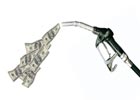Forget the Bank; Go for the Keg

What goes up must get stolen. As gas prices rise, convenience stores and gas stations report drive offs, while some facilities look to security video to identifying the thieves by their license plate.
No shock: The probability of making money, even a reasonably small amount, drives most crime.
The average bank robber, and there’s a lot more today thanks to a lot more branch banks, pulls in less than $5,000; but an annual total can add up to more than $70 million.
The average retail theft loss to shoplifting is about $195 but retail losses add up to more than $25 million a day – that’s a day! And losses from retail employees per incident are significant higher.
Bank robberies and shoplifting incidents yo-yo, going up and down but not by much each year. They are fortunately or unfortunately constant.
However, there’s a new phenomenon to give a headache to security executives and business owners. It’s connected to the high prices of gasoline and scrap metal. A gallon of gas now bounces around $3 to $3.80. And depending on the type of metal (copper, aluminum and brass), the scale can read $3 to 60 cents a pound.
Which is why gas station owners, especially on Fridays, report increasing numbers of gas drive offs. Most gas station and convenience store owners do not report these thefts but some are employing security technology such as outdoor security video, coupled with signage, to mitigate incidents or identify thieves by their license plates.
Stealing Higher-priced Gas
Gas drive offs are a drop in the bucket, although an irritant to station owners who work on a slim margin and who say a number of the thefts are more “forgetfulness” than stealing. The more troubling trend is theft of metal.Construction sites, businesses and even highways are being stripped of metal inside and outside facilities. Thieves, some organized and from overseas, steal stainless steel from storage bins behind businesses; copper wire from construction sites; guardrails from highways; and even – hold onto your hat – beer kegs from breweries and liquor distributors.
Pegging keg losses, the Beer Institute recently suggested that the annual tab could be $50 million and could lead to a shortage of beer during the summer and fall.
Ouch!
The Institute’s Jeff Becker believes that some of the keg losses link to the original buyers of the brew, who trade their deposit for an up to $55 payout from a scrap metal dealer. About 12 percent of beer in the U.S. is sold in metal kegs. But it costs breweries about $150 per keg as a replacement.
Some breweries now are exploring ways to better identify their assets, at least to dissuade scrap and salvage operators from accepting stolen goods. Cities and states also are reacting with tougher laws and regulations.
Ten states already have enacted new scrap metal laws, while another 20 states are considering better legislation. The Institute of Scrap Recycling Industries is trying to police its own. Among the proposals: Sellers must show a government-issued photo identification card; staff records vehicle license plates; dealers participate in a computer database; and many pay by check instead of cash if the amount is above $50.

More expensive scrap metal may lead to beer shortages. The Beer Institute estimates its members will loss $50 million this year in stolen beer kegs.
Tougher Laws
A proposed Ohio law may spur increased use of security video by mandating images “from three perspectives” of items ranging from kegs, grave markers, manhole covers and refrigerators to air conditioners.Of course, no matter if it is copper pipe, beer kegs or hard cash, there has to be a commitment from a victim business to get tough on perpetrators.
But, according to some loss prevention executives interviewed by Security Magazine, a shift on commitment may have dented the profit margin of Wal-Mart stores recently. In public filings analyzed by Wall Street, some suggest $3 billion in shrinkage as, allegedly, the firm shifted loss prevention attention from petty shoplifters to organized gangs. There’s no doubt, however, that retail operations have been targeted by Central American, South American and Pacific Rim groups which are sophisticated and slick. There’s also no doubt that such gangs can reap more per incident than a mom or pop shoplifter. Still, the bottom feeders’ nickels and dimes do add up.
In another business sector, software, the effort to fight theft has recently turned to million dollar whistleblower payouts.
For example, the Business Software Alliance recently announced that it will pay out up to one million dollars to any business employee who turns in his or her company for using unlicensed or pirated software. Some say the proposal is a bit more PR than reality. In about two years, the BSA program hasn’t made much of a dent, with research firm IDC estimating that a little more than 20 percent of software in the U.S. is pirated or unlicensed.

Shrinkage hurts businesses with razor-thin margins. At supermarkets and grocery stores, better designing in of security technologies can help tamp down theft.
Not Really Chump Change
From beer kegs and shoplifting to computer software, the chump change added up fast and big. That’s also the case at grocery stores where the margins are thin and the shrinkage is fat.Writing for the International Foundation for Protection Officers newsletter, Andy Christ, pointed out the prevention aspects of store design. “In my two years of working for a grocery store, I have seen the effects that design can have on the operations in the store. Properly designing the store will not eliminate shoplifting but will help reduce it. Here are some ideas in designing a store from Christ.
Planning store layouts should create obstacles to make theft much more difficult. Access to the offender’s target should be time consuming. This could include a set path from the entrance that the shoppers must follow at first by eliminating shortcuts directly from the entrance to other areas of the store. Doing this would discourage the shoplifter who comes in fast, grabs a specific item and leaves quickly through the entrance. Places where the offender could hide should be eliminated. Public restrooms should be placed close to the front of the store where more people can see who goes in and out.
The necessity, placement and type of security devices should be determined and incorporated into the design of the structure. The store perimeter should have a fence or some other barrier around it so as to limit the access to the store. Windows should be limited to the front of the store. Doors should also be limited to the main doors and emergency exits that are properly alarmed and labeled.
Displaying merchandise near doorways and crowded aisles that obstruct views should be avoided. Mirrors can be used in areas to see around corners, or to make the potential shoplifter think they are being watched (like a camera behind the mirror). The goal of this would be to change the behavior of potential shoplifters. Electronic tags are a possibility for the small, expensive items that grocery stores sell like health and beauty products and cigarettes.

Retail use of payment cards could make the biggest loss difference. According to the Smart Card Alliance, more than 21 million cards are in use in the U.S.
Use Signage
Signs and posters can be used to reinforce security messages. Signs should not only be placed where employees will see them. Signs placed around the store reinforce to the customer that the store is serious about security. Such signs could say ‘We prosecute shoplifters’ in large writing. Also, other signs encouraging parents to watch what their children are doing, and signs that encourage other customers to notify an employee if they see someone shoplifting, are good ideas.Finally, the use of cameras and lighting is important.
Eliminating cash during transactions also has a dampening impact on retail losses.
An outcome of payment cards is higher security. For example, millions of consumers in the United States now enjoy using speedy and convenient contactless financial payment cards and devices every day to pay for purchases at the retail point-of-sale. Capitalizing on the technology, some of the best-known retailers across the nation are now accepting contactless payments. “Contactless financial payments are really catching on with consumers, and issuers and retailers alike are recognizing this trend. More than 21 million contactless cards have been issued in the United States, and more than 51,000 retailers worldwide accept them,” said Randy Vanderhoof, executive director of the Smart Card Alliance.

Tom Conley, president and CEO of The Conley Group, voluntarily undertook the bold initiative to achieve NIMS compliance in order to provide his clients with a high standard of security. His is the first private-sector company to achieve NIMS compliance.
Private Security Company Achieves National Incident Management System Compliance
A private security agency in the United States has completed and achieved full National Incident Management System (NIMS) compliance. The Conley Group, Inc., a Des Moines, Iowa-based security, private investigative and consulting firm, is the first private sector company to achieve the compliance.The U.S. Department of Homeland Security established the NIMS in 2003 to provide a consistent nationwide incident command structure to enable all government, private sector and non-governmental organizations to work together during domestic incidents. Because NIMS is an all-hazards approach, the response under NIMS could be used for acts of terrorism, natural disasters, hazardous materials spills or fires. The response and communications structure are the same for any emergency or disaster no matter how large or how small.
NIMS compliance is a prerequisite for law enforcement agencies, fire services and other public entities to obtain most federal preparedness funding. Currently, there is no statutory requirement for private security agencies to become NIMS-compliant.
Tom Conley, president and CEO, said, “The Conley Group voluntarily undertook the bold initiative to achieve this groundbreaking milestone because being NIMS-compliant will enable us to be far more effective in providing a coordinated, effective response with our public safety partners in time of an emergency or disaster.
“Because we are a non-governmental organization with a public safety mission, our clients should not expect or accept anything less than the ability for us to work hand in hand with public safety agencies.
“My secondary objective is to affect change within the security industry by educating security providers in hopes that they will also become NIMS-compliant on a nationwide basis. As you know, private security personnel in the U.S. already outnumber public law enforcement by nearly a three-to-one ratio. The ratios are far greater for the fire service and EMS. The private security industry is at a crossroads,” said Conley.
The Conley Group Inc. will continue meeting all NIMS compliance requirements to ensure it remains on top of the Homeland Security initiative.
More information about the National Incident Management System can be found at http://www.fema.gov/emergency/nims/index.shtm or at http://www.nimsonline.com/
Looking for a reprint of this article?
From high-res PDFs to custom plaques, order your copy today!




